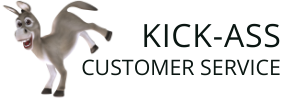Multitasking is the Archenemy of Customer Service
If your business or organization identifies multitasking as a required or desired skill in help-wanted advertisements, please stop!
Earlier this month, I engaged in an experiment that involved reviewing help-wanted advertisements, particularly those relating to customer service. It didn’t take long to find various advertisements seeking applicants with “multitasking” skills, commonly referred to as the “ability to juggle numerous tasks at once.”
You’ve probably seen similar language in help-wanted advertisements. Indeed, it appears that many businesses consider “multitasking” a core skill. Perhaps your organization is one of those businesses and, as such, identifies “multitasking” as either a required or desired skill of applicants.
If so, please stop!
Wait! Did Mark just ask us to stop seeking applicants with “multitasking” skills?
Yes, I did. Please stop! And stop now!
You see, as Dave Crenshaw astutely observes, there is no such thing as “multitasking.” Even a computer’s central processing unit (CPU) doesn’t multitask: instead, it performs only one task at a time. Crenshaw asserts that “multitasking” should instead be referred to as “switchtasking” because people, like CPUs, are capable of performing only one task at a time. In other words, when we engage in “multitasking,” we are really “switchtasking” — that is “switching” back and forth between unrelated tasks.
And there are serious consequences of “switchtasking.” Need proof?
Perform Crenshaw’s short, two-round exercise. In fact, encourage everyone in your business or organization to do the same. I’m serious. It’s fun and easy, and it requires only a single sheet of scratch paper, a pen, and a few minutes. Here’s how it works. (You can also perform this exercise using Crenshaw’s short video.)
- Round 1: In the first round, write the following complete sentence: Switchtasking is a thief. After you finish writing the complete sentence, then write each number from 1 to 21 on a line immediately below. (Why 21? Because there are 21 letters in Switchtasking is a thief.) Be sure to time yourself. Most individuals are able to complete the exercise within 30 seconds.
- Round 2: The second round differs from the first round in one important respect: instead of writing the complete sentence of Switchtasking is a thief and then writing each number from 1 to 21, you’ll alternate — that is, you’ll write the first letter in the sentence, and right below it, the first number; and then you’ll write the second letter in the sentence, and, right below it, the second number. In other words, on the upper line of your scratch paper you’ll write S, and right below the S you’ll write 1. Then, you’ll write w next to the S on the upper line, and right below the w you’ll write 2, and so on. Again, be sure to time yourself.
How did Round 2 go?
- First, if you’re like most people, it took you longer — in fact, probably at least 25% longer — to complete Round 2 as it did to complete Round 1.
- Second, unlike Round 1, you probably made more errors during Round 2; moreover, your handwriting during Round 2 was probably “sloppier” than your handwriting during Round 1.
- Third, your stress level was probably higher during Round 2 when compared with your stress level in Round 1.
A critical lesson can be gleaned from this short and fun exercise. Switchtasking:
- reduces efficiency;
- lowers quality; and
- increases stress.
And this is why businesses and organizations should not encourage “multitasking”: it reduces efficiency, lowers quality, and increases stress.
Next time you’re on the telephone with a customer and find yourself tempted to reply to an unrelated email from the accounting department, stop! Instead, focus exclusively on the customer; accounting can wait. Otherwise, you’re likely to make a mistake not only with the accounting department’s email, but also with the customer.
Have a “customerific” week!
Mark
